Thomas Gainsborough Biography
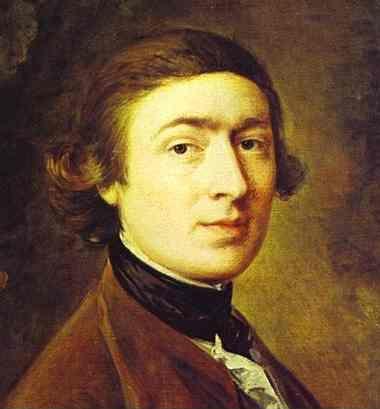
Thomas Gainsborough is an English landscape and portrait painter, one of the great English masters. He was born in Sudbury, Suffolk in the family of a clothier. He showed an aptitude for drawing early and first was encouraged by his mother, who was a woman of well-cultivated mind and excelled in flower-painting. He used to spend a lot of time outdoors, drawing. In 1740, at the age of 13 he was sent to London to study art. He spent several years working in the studios of different artists, one of whom was Hubert Gravelot, a draughtsman and engraver, another one was a scene-painter and illustrator Francis Hayman.
In 1748 Gainsborough presented The Charterhouse(1748) to the Foundling Hospital, it was a way for the artist to show one of his works, because at that time there were no other possibilities for young artists. In 1746 Gainsborough married Margaret Burr, an illegitimate daughter of Duke of Beaufort. His wife brought the family an annuity of £200, which enabled him to start his career as a portrait-painter in Ipswich.
He first did not have many commissions there and had a lot of time to indulge in his favorite pursuit: to draw landscapes. Also he created many beautiful pictures of his wife and daughters such as Self-Portrait with His Wife, Margaret (probably) (1746-1747), Thomas Gainsborough, with His Wife and Elder Daughter, Mary, (About 1751-2), The Painter's Daughters, Margaret and Mary, Chasing Butterfly, (about 1756), The Painter's Daughters, Margaret and Mary, Holding a Cat, (About 1759). The most notable portraits of that period are Robert Andrews and His Wife Frances(about 1748-49), Heneage Lloyd and His Sister (1750s), William Wollaston. (about 1758-1759).
In 1760 Gainsborough decided to move to Bath, where it was possible for him to have portraits commissioned by the much wealthier and nobler persons. Bath, famous for its mineral waters, was the principal lounging place for persons of wealth and leisure in winter. Gainsborough became well-known there in his first year after moving and since then always had a lot of sitters. His portraits combine the elegance of Van Dyck with his own characteristic informality. There are such early masterpieces as Mrs. Philip Thicknesse (1760), Mary, Countess Howe (about 1763-4), The Blue Boy (exhibited R.A. 1770), and the landscape The Harvest Wagon (exhibited S.A. 1767). In 1768 he became one of the foundation members of the Royal Academy, at which he exhibited annually until 1784, when he retired after the disagreement over the hanging of his pictures at the exhibition.
In 1774 Gainsborough moved to London. He was an established master by then. To this last great period of his life belong such masterpieces of portraiture as The Hon. Mrs. Thomas Graham (exhibited R.A. 1777), The Hon. Frances Duncombe (about 1778), Mrs. Thomas Gainsborough, nee Margaret Burr (about 1778), Georgiana, Duchess of Devonshire (1783), Mrs. Richard Brinsley Sheridan, née Elizabeth Linley (1785), William Hallett and His Wife Elizabeth, nee Stephen, known as "The Morning Walk" (1785), Mrs. Sarah Siddons (1785), and landscapes The Watering Place (1777), The Cottage Door (exhibited R.A. 1780). Mountain Landscape with Peasants Crossing a Bridge (1784), The Woodsman (1787-1788). He died from cancer on the 3rd of August, 1788 and was buried in Kew.
Bibliography
Gainsborough: Paintings and Drawings. by J. Hayes. London. 1975.
Thomas Gainsborough. By Ye. Nekrasova. M. 1990.
Painting of Europe. XIII-XX centuries. Encyclopedic Dictionary. Moscow. Iskusstvo. 1999.
Gainsborough (World of Art) by William Vaughan, Michael J. Lewis. Thames & Hudson, 2002.
Gainsborough: The Painter in Modern Culture by Michael Rosenthal, Martin Myrone. Tate Gallery Publishing Ltd, 2002.
The Letters of Thomas Gainsborough by John Hayes. Paul Mellon Center, 2001.
Drawings of Thomas Gainsborough by John Hayes. Yale Univ Pr, 1971.
Sensation and Sensibility: Viewing Gainsborough's "Cottage Door" by Ann Bermingham. Yale University Press, 2005.
Gainsborough in Bath by Susan Sloman. Paul Mellon Center, 2002.
Gainsborough And His Place In English Art by Walter Armstrong. Kessinger Publishing, 2004.
- The Charterhouse.
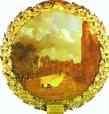
1748. Presented to the Foundling Hospital by the artist. Oil on canvas. Thomas Coram Foundation, London, UK.
- Mrs. Thomas Gainsborough, Nee Margaret Burr.
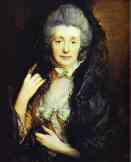
About 1778. Coutauld Institute Galleries, London, UK.
- Self-Portrait With His Wife, Margaret (Probably).
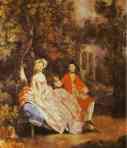
1746-47. Oil on canvas. Louvre, Paris, France.
- Thomas Gainsborough, With His Wife And Elder Daughter, Mary.
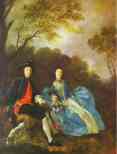
1751-52. Oil on canvas. Marquis of Cholmondeley, Houghton, UK.
- The Painter's Daughters, Margaret And Mary, Chasing Butterfly.
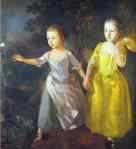
About 1756. National Gallery, London, UK.